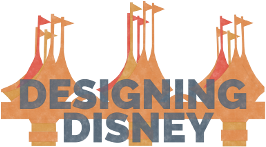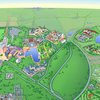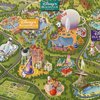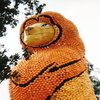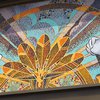Disney Las Vegas – The Euro Disney Hotel That Never Was
As discussed in a previous article , a group of architects was asked by The Walt Disney Company to create a site plan for Euro Disney’s resort center. Once the layout was completed, an international architectural competition was organized for the design of the hotels.

One of the contestants was mister Robert Venturi. He suggested a 1960’s Las Vegas themed hotel called “Disney Las Vegas”. The first rendering very much recalls the simplicity of the famous “Stardust” hotel (Las Vegas, 1958 – 2006).



Later renderings / models show a less 1960’s style façade adorned with an explosion-like neon sign reading “Fantasia” written in the iconic “Stardust” font.



Venturi also suggested putting huge neon signs of Disney characters in equal distance from each other on both sides of the long central boulevard that goes all the way from the A4 interchange to the Disneyland Hotel (Avenue Paul Séramy).




At first sight, the design of the hotel and the idea of putting neon signs along the central boulevard might seem rather abstract and tacky. But it isn’t!


In this article, we will point out the reasoning behind Venturi’s suggestions and explain why it didn’t get built. For this purpose, it is necessary to speak about Venturi himself and the notion of architectural postmodernism.
The Postmodernist movement has its roots in the United States of the sixties and seventies. Postmodernism – as the term implies – followed modernism and is a reaction to it.
Modernist architecture is characterized by functional buildings that have simple forms and no decoration. The design isn’t inspired by historical styles and doesn’t aim at conveying a meaning.


Postmodernist architecture is characterized by buildings that were built to be playful and have extravagant forms and facades. The design is inspired by historical styles and aims at conveying a meaning.

Robert Venturi was the leading force of the Postmodern movement. In his book “Complexity and Contradiction in Architecture” (1966) he stated that:
“Architects can bemoan or try to ignore (ornamental and decorative elements in buildings) or try to abolish them, but they will not go away. Or they will not go away for a long time, because architects do not have the power to replace them (nor do they know what to replace them with)”.
Venturi ascribed to ornaments and decoration the power to communicate meaning to and differentiate buildings from each other. They “accommodate existing needs for variety and communication”.
He proved this theory in “Learning from Las Vegas” (1972 & 1977), one of the most fundamental architectural writings of the last century. This book is the result of his field studies in the Las Vegas of the late 1960’s.

Back in those days, the Las Vegas strip was less densely developed and the themed architecture of the rather small hotels and billboards stood in sharp contrast to the asphalt boulevard and surrounding dessert. Among the Strip’s first casino hotels were the New Frontier, Caesar’s Palace, the Riviera and the Stardust.

To Venturi, the hotels and casinos on the Strip were “decorated sheds”. They were simple, almost identical box-like buildings that could only be differentiated by their themed decoration, billboards and neon signs. These elements communicated their function as well. Without the decorations, billboards and signs, all structures would look the same and people wouldn’t know what is going on inside.

Venturi regarded this new city with its highly diverse architecture and abundance of billboards as functional and human at the same time. He considered places like Las Vegas (and Disneyland) as closer to what people really wanted than anything the Modernist elite of architects had ever built.

Roughly 20 years after his legendary trip, Robert Venturi was asked to cooperate with The Walt Disney Company and several of his postmodernist colleagues on the Euro Disney project. The ideas he submitted clearly reflect his trip to Las Vegas in the late 1960’s.

The neon signs of Disney characters, that would serve as a playful prelude to a day in the Magic Kingdom, must be interpreted as a reference to Venturi’s appreciation of Las Vegas’ neon signs.

And his “Disney Las Vegas” hotel was an accurate expression of what Las Vegas architecture is all about: a simple, box-like building hidden behind a huge billboard.


People familiar with the characteristic of Las Vegas architecture (as described above) will confirm the beauty and relevance of the hotel’s design. But people who don’t, will think it looks rather abstract and tacky.


And that’s most likely the reason why The Walt Disney Company decided not to build it. It was too grown up and intellectual. And Venturi’s design probably entailed too much of a sense of irony…
After all, should there be a theme hotel of a theme city?
“Avenue Paul Séramy” – July 2013


This article was written together with our good friend Will. His fascination and appreciation for Disney started with the opening of Euro Disneyland in 1992. Coming from an American Cultural Studies background, Will today is most interested in the original concept of the Euro Disney Resort and the cultural messages that the Walt Disney Company wanted to convey about the United States back in the late 1980s. To Will, the 1992 Euro Disney complex is an outstanding example of postmodern architecture and culture, which should be maintained in and reconstructed to its original state as closely as possible. These concerns and interests lead the author to follow and support 'Designing Disney'. We would like to sincerely thank Will for the efforts that he has made!
Credits
Photos “Avenue Paul Séramy”: Bert Snyers
